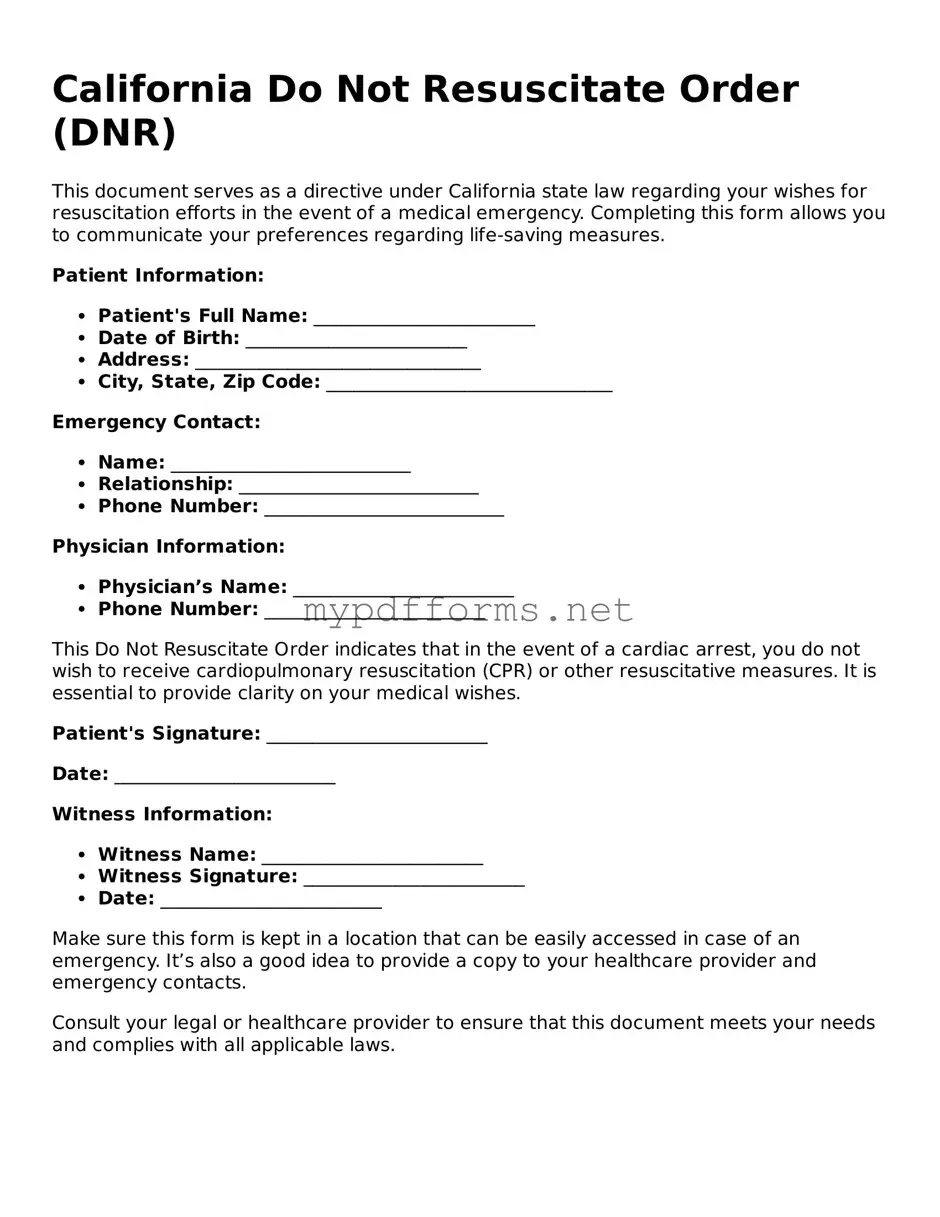The California Do Not Resuscitate (DNR) Order form shares similarities with the Advance Healthcare Directive. Both documents allow individuals to express their healthcare preferences in advance. An Advance Healthcare Directive encompasses a broader scope, allowing individuals to designate a healthcare agent and outline their wishes regarding various medical treatments. While a DNR specifically addresses resuscitation efforts, the Advance Healthcare Directive can cover a range of medical decisions, ensuring that a person's overall healthcare preferences are honored.
Another document similar to the DNR is the Physician Orders for Life-Sustaining Treatment (POLST) form. The POLST form is designed for individuals with serious illnesses or those who are nearing the end of life. Like the DNR, it provides clear instructions about the types of medical interventions a patient desires or does not desire. However, the POLST form is more comprehensive, addressing various treatments beyond resuscitation, such as intubation and artificial nutrition, making it a vital tool for patients who want to ensure their specific wishes are followed.
The Medical Power of Attorney (MPOA) is another document that parallels the DNR Order. An MPOA allows individuals to appoint someone to make medical decisions on their behalf if they become unable to do so. While a DNR focuses solely on resuscitation preferences, the MPOA encompasses a wider range of medical choices. This document ensures that a trusted person can advocate for a patient’s wishes, including decisions about resuscitation efforts, in situations where the individual cannot communicate their desires.
Similar to the DNR Order, the Living Will is a document that outlines a person's preferences regarding medical treatment in situations where they cannot express their wishes. Living Wills typically address end-of-life care and specify whether individuals want to receive life-sustaining treatment. Although the DNR focuses specifically on resuscitation, the Living Will provides a broader framework for addressing various medical interventions, ensuring that a person's values and preferences are respected during critical healthcare decisions.
The New Jersey ATV Bill of Sale form is a vital document for the transfer of ownership of an all-terrain vehicle (ATV) from seller to buyer in New Jersey. This form ensures that the sale is legally documented, with all necessary details accurately recorded, making it essential for registration, tax, and legal purposes. For those looking for convenient resources, NJ PDF Forms offers an editable option for this important document.
The Health Care Proxy is another document that shares characteristics with the DNR Order. A Health Care Proxy allows individuals to appoint someone to make healthcare decisions on their behalf if they are incapacitated. While the DNR specifies preferences regarding resuscitation, the Health Care Proxy grants authority to a designated person to make decisions about all medical treatments, including resuscitation efforts. This document emphasizes the importance of having a trusted advocate who understands the patient’s wishes.
The Comfort Care Order, like the DNR, focuses on the patient’s comfort and quality of life during serious illness or at the end of life. This document prioritizes palliative care and pain management over aggressive treatment measures. While a DNR specifically instructs against resuscitation, a Comfort Care Order emphasizes the need for compassionate care, ensuring that patients receive relief from suffering without unnecessary interventions. Both documents reflect a patient-centered approach to healthcare decision-making.
Finally, the Do Not Intubate (DNI) Order is closely related to the DNR. A DNI specifically instructs healthcare providers not to place a patient on a ventilator if they are unable to breathe independently. While a DNR addresses the broader scope of resuscitation efforts, the DNI focuses solely on the use of intubation. Both documents serve to clarify a patient’s preferences regarding life-sustaining measures, ensuring that their wishes are respected in critical situations.
